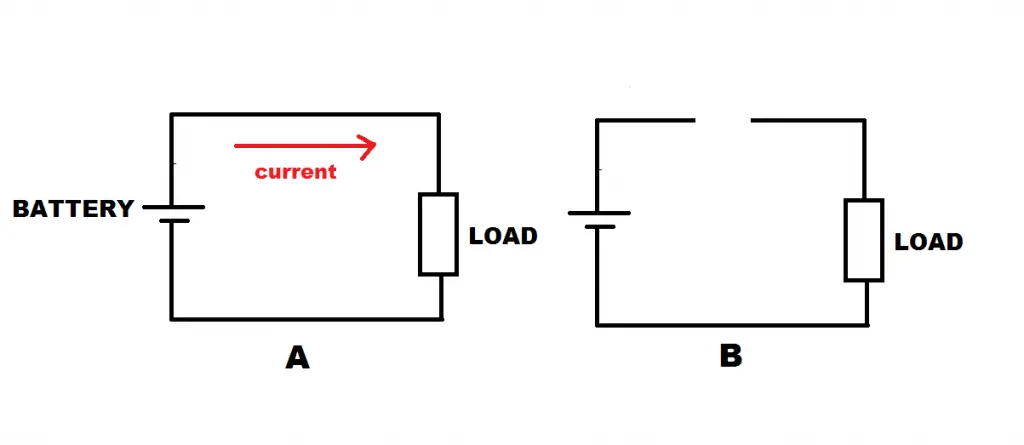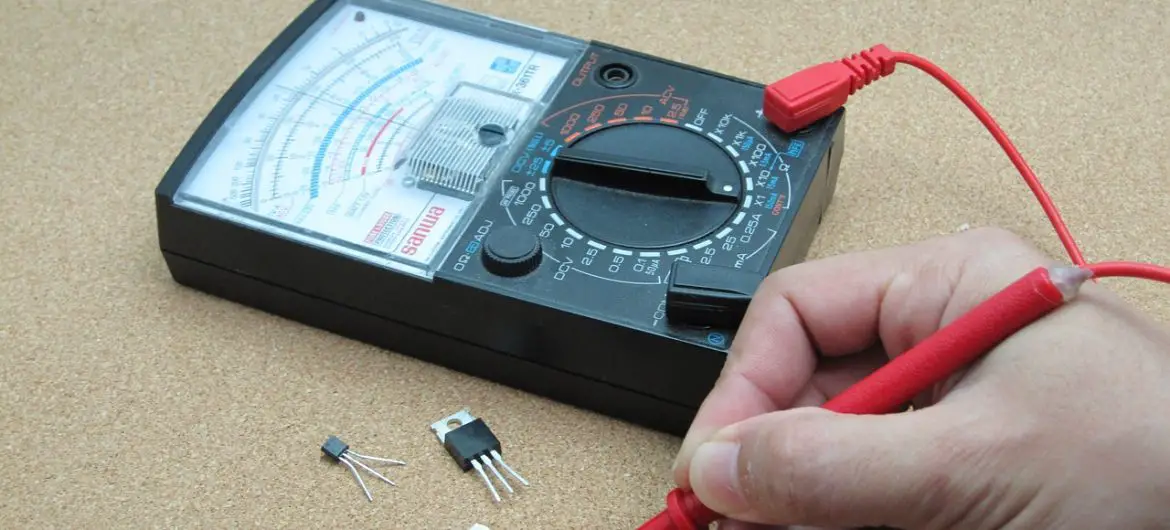In the field of electricity, there are many different quantities in play.
These quantities include things like current, voltage, resistance,capacitance, inductance and a whole list of others.
When designing a circuit, or testing a circuit for faults, you need to have a way of being able to measure these different quantities.
Otherwise things could get messy real fast.
An analog multimeter is an electronic and electrical measuring instrument that is used to measure a number of different electrical quantities.
The uses of an analog multimeter include;
- Measuring Voltage
- Measuring Current
- Measuring Resistance
- Transistor testing
- Diode testing
- Continuity test
What is an analog multimeter
The Analog multimeter uses a needle that is placed on a numbered scale (that has a specified range), to display a number of different quantities as pictured in the image below.

When the analog multimeter is used to measure these quantities, the needle is deflected depending on the force generated by the quantity being measured.
Inside the multimeter is a drum (which has a coil wound around it) between a pair of permanent magnets.
A magnetic field is induced, when a current passes through the coil.
Since a magnetic field already exists due to the magnetic field, it reacts with the induced magnetic field causing a force which moves the needle.
6 uses of an analog multimeter
The analog multimeter has many different functions and uses, which make it a vital measuring instrument.
Let’s take a look at the different uses of an analog multimeter.
Use #1 of an analog multimeter: Measuring Voltage
Voltage is one of the most important aspects of any electrical or electronic circuit.
It is the force that is generated by a power source (like a battery) that pushes electrons (current) around a closed circuit.
In simple words voltage is electrical pressure.
Why is it important for an analog multimeter to measure voltage?
When an electrical or electronic circuit is built, it is created with components to work within a certain range of voltage values.
This is because all components have minimum and maximum values within which they operate efficiently.
Operating outside of these thresholds will cause the component to fail, which will also have a domino effect causing the rest of the circuit to fail.
So, having the ability to check that the right voltages are present between any two points in a circuit is needed.
Also, if for some reason a component has stopped working, an analog multimeter can be used to check the voltage across it to see whether there is a Short or Open circuit.
Another great reason is checking the voltage of your power source.
You might be powering your circuit with a power supply which is fine as it displays the voltage, but what if you are using batteries? How will you know if it is providing the right voltage to power your circuit.
Again that is where the analog multimeter’s voltage measuring function comes in handy.
Use #2 of an analog multimeter: Measuring Current
Those charged electrons that move around a circuit that receive the force from the voltage are also known as Current.
A more detailed description of Current would be the amount of charge that passes a given point in a circuit within a specific time period.
The magnitude of the current is given in Amperes (A).
Without getting into too much detail, the molecular structure of materials contains electrons. Depending on the material in question, the electrons can be held tightly or loosely.
When the electrons move within a material it is known as current. How well and how many electrons move governs the substance’s ability to conduct electricity.
Just like voltage, there are many reasons why it is essential to be able to measure current using an analog multimeter.
One reason for measuring current is to see how much current a circuit or component consumes.
If you are designing a circuit that runs off a limited power source (like a battery), you want to be able to extend its lifetime as much as possible.
While theory and calculation can give you an indication of how much current a circuit or component will consume, there are many factors that come into play in the real world.
You can use an analog multimeter to measure how much current is being consumed that will give a better indication than just theory alone.
The next reason is again along the same lines of measuring voltage.
Like voltage ratings, electronic components have current ratings too.
Exceeding these current ratings can cause irreversible damage. So having a way to measure how much current is being supplied to them using an analog multimeter is a necessity.
Use #3 of an analog multimeter: Measuring Resistance
So, voltage is the force that pushes electrons, and current is the number of electrons that pass a given point.
Resistance is the ability of a material to resist current.
Voltage, current and resistance are closely related, and make up the fundamentals of electricity.
Their relationship can be summed by using Ohm’s law.
Ohm’s law sums up the relationship between Voltage, Current and Resistance. The formula can be seen below.

So the final piece of the puzzle is measuring resistance.
If you want to decrease the current flowing in a circuit you will need to increase the resistance of the circuit and vice versa.
Everything in a circuit like a battery, wires, and electronic components have some sort of resistance which adds up to the overall resistance of the circuit.
But, there are specific passive components known as Resistors that are created with a known resistance so you can increase or decrease the resistance of a circuit as desired.
Being able to measure the resistance using an analog multimeter lets you design a circuit as close to the desired resistance value as possible.
Since you cannot really know the resistance values of other components other than resistors, being able to measure their resistance is very helpful.
While resistors have colour bands on them indicating their resistances, it can be time consuming trying to figure out what the value is. Sometimes it’s much easier to just use the analog multimeter to read the resistance.
Use #4 of an analog multimeter: Continuity test
For a current to flow, it requires an unbroken path.
If that path is unbroken it will stop the flow of current within that circuit as can seen below.

Diagram A shows a circuit that has an unbroken path. Here current can flow without any interruptions.
The circuit in diagram B has a break in the circuit, therefore no current can flow.
Circuits and components are connected together using wires of varying lengths, materials and diameters.
However, these wires are shielded to protect us and other parts of the circuit.
So, if you have a long thick wire that has a break somewhere in the middle, it is going to be very hard to know what the real issue is.
Analog multimeters have the ability to test the Continuity, which is the presence of a complete path that electrons can flow through.
It not only can test the continuity of wires, but of switches, fuses, conductors and certain components.
For example, you can test if a MOSFET is damaged or not not using the continuity test.
When the leads of the multimeter are placed between the Source and Gate terminals of the MOSFET, there should be no continuity.
An analog multimeter lets you know if there is continuity using an audible beeping sound.
Use #5 of an analog multimeter: Diode and Transistor testing
Diodes are electronic components that can be found in almost every circuit.
Their most common applications include protection, rectification and switching.
Unfortunately for the Diode, they tend to be the first to get damaged when a fault arises. So, having a way to test whether it has been damaged or not is essential.
Lucky for you and me, analog multimeters can test a diode to check it is functioning as it should be or whether it needs to be disposed of.
The Light Emitting Diode (LED) is a type of diode which has the ability to emit light when forward biased.
Just like a conventional diode, we can test a LED using an analog multimeter to see if it is working.
As well as the diode, the analog can be used to test the functionality of a Transistor.
The Transistor is a semiconductor device used mainly to amplify or switch electronic signals and electrical power.
Testing a transistor using an analog multimeter follows a similar procedure to testing a diode. This is due to the fact that a bipolar transistor closely resembles back to back diodes.
Use #6 of an analog multimeter: hFE amplification test
A hFE (Hybrid parameter forward current gain, common emitter) amplification is the current gain of a transistor.
This number represents the factor that the base current of the transistor is amplified to produce the output amplified current.
So, for example if a transistor had a base current of 1mA, and a hFE of 100, the output current at the collector of the transistor would be 100 mA.
Analog multimeters are equipped with a function that allows you to find out what a transistor’s hFE value is.
Being able to test the hFE (gain) of a transistor comes in handy when you might have transistors lying around and aren’t too sure of hFE value.
Applications of an analog multimeter
You can see the analog multimeter has many great uses and abilities.
But, what applications are these functionalities commonly used for and who tend to use them?
Since the multimeter is a device that is primarily used with electricity, anyone who deals with electricity, would use the multimeter.
This can include;
- Electricians,
- Electrical and Electronic Engineers
- Scientists
- Automotive Engineers
- Mechanics
- Line installers and repairers
The main most common use for an analog multimeter is Fault Finding or Circuit Analysis.
As the name suggests, this involves finding faults in a circuit, wire, component etc, that is not working.
There are many ways to approach fault finding, each with their own pros and cons depending on the circumstance.
Other than that, analog multimeters are also used in the design process of electrical and electronic systems to ensure components are functioning, as well as having the right values.
Does an an analog multimeter have the same uses as a digital multimeter
The analog multimeter is less commonly used in the electrical and electronic field due to the rise of digital electronics.
You can now use a Digital Multimeter (DMM) to perform the same tasks as its older counterpart.
However, they both have similar uses, but each having its own pros and cons which I will discuss below.
Difference between an analog and digital multimeter
When it comes to the multimeter, you have two options; Analog or Digital.
While both are used for the same purpose, they do have their differences.
So, before diving into what are the uses of an Analog multimeter, let’s quickly identify the main differences between an Analog and Digital multimeter.
Display – The first most obvious difference between an Analog and Digital multimeter is the display. The analog multimeter uses a needle to show the measured quantity, whereas the digital multimeter displays information in the form of digits.
This is similar to the difference between an Analog and Digital clock.
Cost – The analog multimeter is less expensive compared to its digital counterpart due to the way that it is constructed and the components that it uses.
Accuracy – Since the analog multimeter uses a needle pointer to display values, this can increase the amount of parallax error when being read by the user giving it a lower accuracy.
Input Resistance – The input resistance of an Analog multimeter varies with range, while a digital multimeter stays constant for all ranges.





